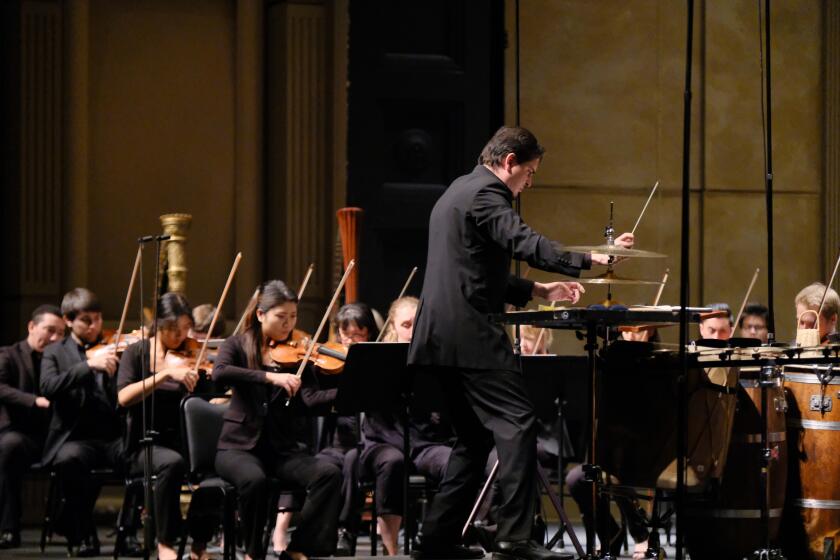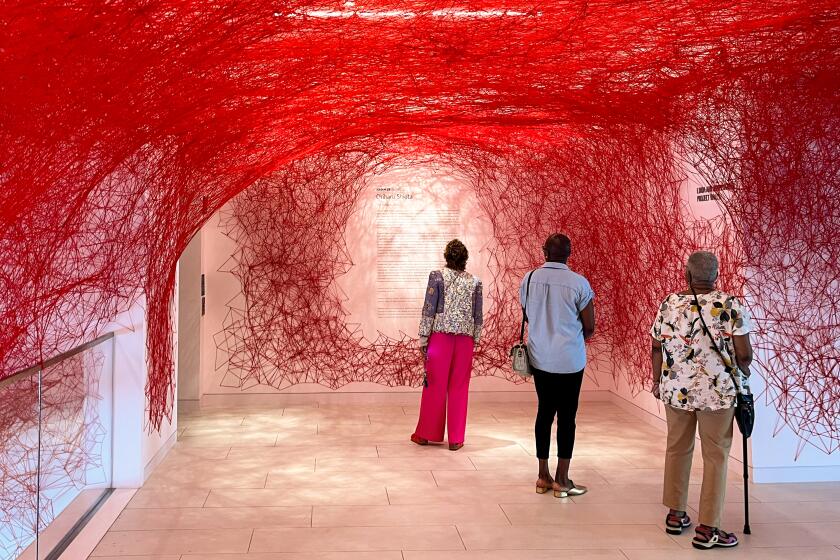POISED AMONG THE GOOD, THE BAD AND THE ARTY
Good art gives us a chance to walk a mile in somebody else’s shoes, sandals, jackboots or wedgies. Francesco Clemente’s work gives one a sense of shuffling along naked in rhinestone-crusted velvet slippers with curled-up toes. Its vectors are a mixture of fairy tale and Krafft-Ebing.
Clemente is, of course, a star of the Italian branch of Neo-Expressionism, along with Sandro Chia and Enzo Cucchi--the three C’s. He had his first New York show in 1980, long enough ago to allow his reputation soaring surges and precipitous plunges on the unofficial charts of an art sphere bent on behaving like a combination of the stock market and the rock music scene. For all of that, we have seen precious little of Clemente’s work on the West Coast, excepting a small show at Cal State Long Beach.
Now, until Sept. 12, UC Berkeley’s art museum hosts an exhibition organized by the Ringling Museum in Sarasota, Fla. The curator is Michael Auping of the Albright-Knox Gallery in Buffalo. He put together a package of 65 paintings and graphics executed between 1979 and 1983. That turns out to be enough to form an impression but too little to be satisfying.
Clemente was born in Naples in 1952. These days, he divides his time between studios in Rome, New York and Madras, India, where he travels with his wife and two children. The art has a strange, placeless ambiance, as if it all takes place inside its maker’s mind, an impression borne out by the fact that nine-tenths of the male figures seem to be self-portraits. Female, too. One double self-portrait is titled “She and She.”
The art projects an aura of hope and constantly wounded innocence, as if its guiding sprit were a picaresque adolescent Candide transformed into an urchin hooker on the borders of the Casablanca casbah.
The first large picture encountered is called “Two Painters” and depicts standing nude males in a landscape. The figures are rendered with a flat, decorative style that could as easily derive from an elementary school health class text illustration as from the Indian miniature style that’s probably its actual inspiration. The sweetness of that style makes it impossible to know whether the men are fighting or caressing, an ambiguous impression reinforced by a landscape that looks like a vaudeville scene painter’s idea of Impressionism.
The picture seems to say, “I don’t exactly understand what is going on here but whatever it is, it probably has to be that way, and it is kind of pretty.”
Nothing in art plays a more dangerous game than cuteness. There are moments when Clemente looks like a kinky Marc Chagall. We are constantly on the brink of walking away from them, either for pandering or for being too dumb to credit. Clemente, it must be confessed, uses the device with extraordinary deftness. He holds our sympathetic attention.
Looking at these pictures feels like falling into a conversation with a languorous teen-ager on the Orient Express. The kid is so beautiful, narcissistic and full of little pouts and puckers that his putative masculinity is constantly going out of focus. He is polite to the point of delicacy and witty as a geisha. You figure this creature had to be brought up in a palace monastery, but an hour’s conversation reveals he’s seen more of the underbelly of life in 10 years than you’ve seen in 40, and thank goodness.
Clemente paints subject matter that would be either provocative or repellent in other hands. He is fascinated with feces and manic for masturbation but presents the subjects with a wide-eyed candor that takes you back to the moment Mama said it was wrong. Maybe it wasn’t, after all.
A large triptych called “The Battle of the Paintings” shows a nude female figure with a protective umbrella amid primitive coupling couples. The central panel is a male orgy. The final scene shows a man putting a gun in his mouth while his Thurber-like dog looks on, concerned.
In “He Teaches Emotions With Feeling,” we see a nude male, probably bound, being touched on the face and genitals by arms that reach in from the side of the picture. In the central panel, he makes a gesture of disgust. In the final scene, he is transformed into a rose bush.
In the short trajectory of Clemente’s art shown here, there seems to be some emotional movement from sweetness to agitation and anger. Our masochistic Candide does not judge the things that happen to him; they are just the things that happen. But sometimes when it all gets too heavy, he wishes he didn’t always feel guilty about everything. He wishes he could be magically transformed into a flower. Especially when he gets some bad dope and he feels like there’s a head screaming out of every hole in his head. His ears scream. His eyes scream. He longs for religious deliverance, but when he sees the Shroud of Turin, it has a large penis impressed thereon.
There is a persuasive candor about this art. You find yourself saying “I think I know what you mean” to experiences you never want to have. This is possible because Clemente manages to avoid the pitfall of making you feel this is all the expression of some perverse little creep. He maintains an aura of purity that is the saving grace of this art’s message.
Unfortunately, that virginal aura is only guarded at a high price. To constantly remind us of gentleness and sincerity, he has to paint thinly and awkwardly or with a certain number of galumphing fumbles. It looks like Bad Art. It plays with elements of amateur efforts because we recognize that every art has a particular expressive edge and sometimes that edge is inseparable from poor technique. Clemente handles Bad Art elements to good effect but falls into the virtually inevitable trap of himself making bad art. Once you get the message of such work, you don’t want to look at it twice. It has no density beyond its mind games.
As to that, Auping’s catalogue essay points out that Clemente has expressed an ambition to work like a dilettante. The essay finds a whole cornucopia of esoteric influence in the work, from allusions to classical literary works like “The Golden Ass” to current critical fascination with semiotics and a galaxy of artistic crosscurrents.
Much of the linkage sounds like pure eyewash woven together by bright, bored contemplation. Yet even that contributes to a growing feeling that what is wrong here is that the sensibility expressed is clear but too limited to be of more that specialized interest. It is exotic like the Lawrence Durrell of “The Alexandria Quartet” or the drug-dream prose of William Burroughs, with none of their formal originality or echoes of larger human experience.
Clemente’s drawing, unlike his painting, is deft, probing and sharp, like that of David Hockney, but the general oeuvre doesn’t jell into anything. Its innocence is tainted by its decadence, its metaphysical longings are arrested by its fairyland childishness. It needs desperately to achieve universality so that we can read it allegorically in mythic Jungian terms. Its self-centering leaves it Freudian and particularized. Just some guy’s personal fantasies.
I don’t think this art has much to do with larger life. If it does, it is with the immaturity that infects the upper reaches of this culture because of pervasive narcissism. Nah, Clemente’s art is even more minor that that. It is about the reedy note of poignancy broadcast by young guys loafing along on Santa Monica Boulevard, hoping to realize their Hollywood dreams with a quick pickup.
The exhibition will appear in Los Angeles next year at the Museum of Contemporary Art, Feb. 8 through March 29.
More to Read
The biggest entertainment stories
Get our big stories about Hollywood, film, television, music, arts, culture and more right in your inbox as soon as they publish.
You may occasionally receive promotional content from the Los Angeles Times.






